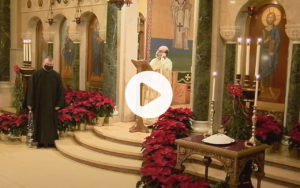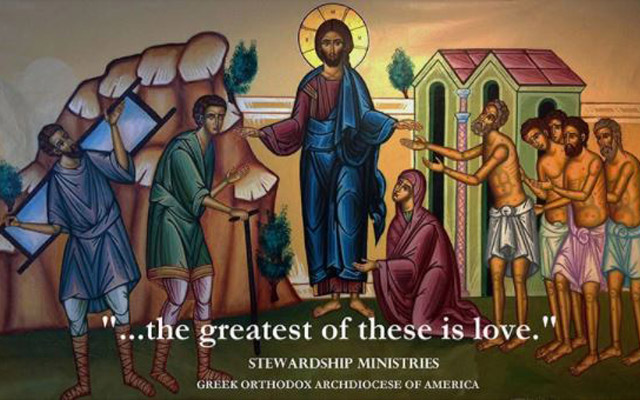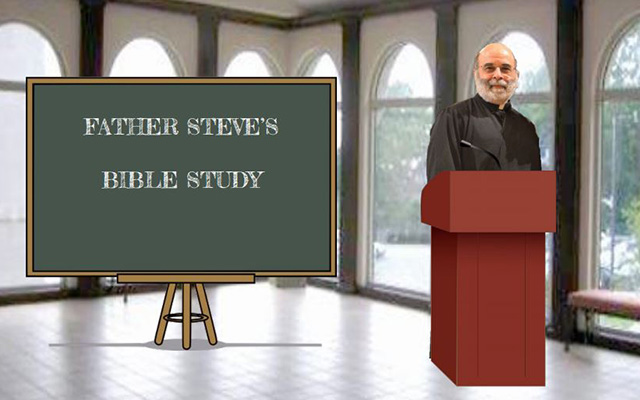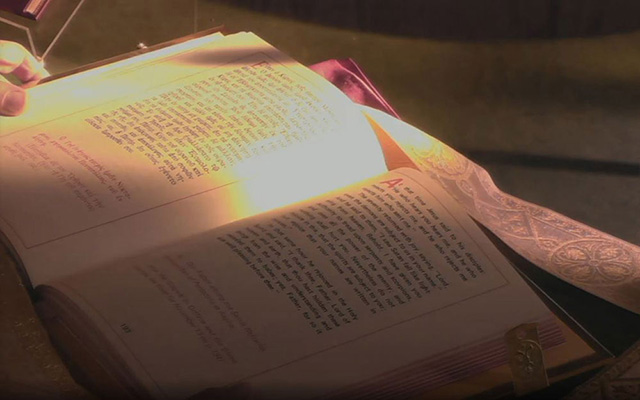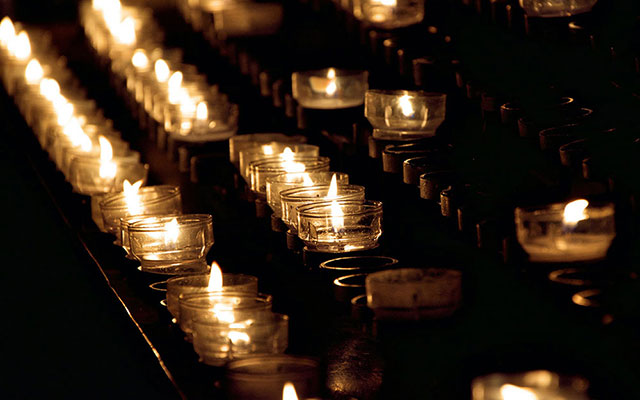Jesus did not live with his disciples after his resurrection as he had before his death. Filled with the glory of his divinity, he appeared at different times and places to his people, assuring them that it was he, truly alive in his risen and glorified body.
To them he presented himself alive after his passion by many proofs, appearing to them during forty days, and speaking of the Kingdom of God (Acts 1:3).
It should be noted that the time span of forty days is used many times in the Bible and signifies a temporal period of completeness and sufficiency (Gen 7:17; Ex 16:35, 24:18; Judg 3:11; 1 Sam 17:16; 1 Kg 19:8; Jon 3:4; Mt 4:2). On the fortieth day after his passover, Jesus ascended into heaven to be glorified on the right hand of God (Acts 1:9-11; Mk 16:19; Lk 24:51). The ascension of Christ is his final physical departure from this world after the resurrection. It is the formal completion of his mission in this world as the Messianic Saviour. It is his glorious return to the Father who had sent him into the world to accomplish the work that he had given him to do (Jn 17:4-5).
… and lifting his hands he blessed them. While blessing them, he parted from them and was carried up into heaven. And they returned to Jerusalem with great joy. … (Lk 24:51-52).
The Church’s celebration of the ascension, as all such festal celebrations, is not merely the remembrance of an event in Christ’s life. Indeed, the ascension itself is not to be understood as though it were simply the supernatural event of a man floating up and away into the skies. The holy scripture stresses Christ’s physical departure and his glorification with God the Father, together with the great joy which his disciples had as they received the promise of the Holy Spirit who was to come to assure the Lord’s presence with them, enabling them to be his witnesses to the ends of earth (Lk 24:48-53; Acts 1:8-11; Mt 28:20; Mk 16:16-14).
In the Church the believers in Christ celebrate these very same realities with the conviction that it is for them and for all men that Christ’s departure from this world has taken place. The Lord leaves in order to be glorified with God the Father and to glorify us with himself. He goes in order to “prepare a place” for and to take us also into the blessedness of God s presence. He goes to open the way for all flesh into the “heavenly sanctuary … the Holy Place not made by hands” (see Hebrews 8-10). He goes in order send the Holy Spirit, who proceeds from the Father to bear witness to him and his gospel in the world, making him powerfully present in the lives of disciples.
The liturgical hymns of the feast of the Ascension sing of all of these things. The antiphonal verses of the Divine Liturgy are taken from Psalms 47, 48, and 49. The troparion of the feast which is sung at the small entrance is also used as the post communion hymn.
Thou hast ascended in glory O Christ our God, granting joy to Thy disciples by the promise of the Holy Spirit. Through the blessing they were assured that Thou art the Son of God, the Redeemer of the world! (Troparion).
When Thou didst fulfill the dispensation for our sake, and didst unite earth to heaven, Thou didst ascend in glory, O Christ our God, not being parted from those who love Thee, but remaining with them and crying: I am with you and no one will be against you! (Kontakion).
~Website of the Orthodox Church in America (OCA), Volume II—Worship: The Church Year, (http://oca.org/orthodoxy/the-orthodox-faith/worship/the-church-year/ascension1).
The Fall of Constantinople, May 29, 1453
THE CAPTIVE CHURCH, by Aristeides Papadakis, Ph.D.
In general, the fall of Constantinople in 1453 was a great misfortune for Christianity. For Eastern Christendom it was nothing less than an unqualified disaster. As a result of the Ottoman conquest, the entire Orthodox communion of the Balkans and the Near East was suddenly isolated from the West. For the next four hundred years it would instead be confined within a hostile Islamic world, with which it had little in common religiously or culturally. Orthodox Russia alone escaped this fate. It is this geographical and intellectual confinement which, in part, explains Orthodoxy’s silence during the Reformation in sixteenth century Europe. That this important theological debate should often seem distorted to the Orthodox is not surprising: they never took part in it. And yet, it is not the isolation alone, but the consequences of Ottoman rule that make these pages of Church history so bleak from virtually every point of view.
The new Ottoman government that arose from the ashes of Byzantine civilization was neither primitive nor barbaric. Islam not only recognized Jesus as a great prophet, but tolerated Christians as another People of the Book. As such, the Church was not extinguished nor was its canonical and hierarchical organization significantly disrupted. Its administration continued to function. One of the first things that Mehmet the Conqueror did was to allow the Church to elect a new patriarch, Gennadius Scholarius. The Hagia Sophia and the Parthenon, which had been Christian churches for nearly a millennium were, admittedly, converted into mosques, yet countless other churches, both in Constantinople and elsewhere, remained in Christian hands. Moreover, it is striking that the patriarch’s and the hierarchy’s position was considerably strengthened and their power increased. They were endowed with civil as well as ecclesiastical power over all Christians in Ottoman territories. Because Islamic law makes no distinction between nationality and religion, all Christians, regardless of their language or nationality, were viewed as a single millet, or nation. The patriarch, as the highest ranking hierarch, was thus invested with civil and religious authority and made ethnarch, head of the entire Christian Orthodox population. Practically, this meant that all Orthodox Churches within Ottoman territory were under Constantinople. The authority and jurisdictional frontiers of the patriarch, in short, were enormously enlarged.
Still, on balance, all these rights and privileges, including freedom of worship and religious organization, seldom corresponded to reality. The legal privileges of the patriarch and the Church depended, in fact, on the whim and mercy of the Sultan and the Sublime Porte, while all Christians were viewed as little more than second-class citizens. Moreover, Turkish corruption and brutality were not a myth. That it was the “infidel” Christian who experienced this more than anyone else is not in doubt. Nor were pogroms of Christians in these centuries unknown. Devastating, too, for the Church was the fact that it could not bear witness to Christ. Missionary work among Moslems was dangerous and indeed impossible, whereas conversion to Islam was entirely legal and permissible. On the other hand, converts to Islam who returned to Orthodoxy were put to death. Of a piece with this grim situation was the fact that new churches could not be built and even the ringing of church bells was not allowed.
Finally, the education of the clergy and the Christian population fared no better – it either ceased or was of a rudimentary kind.
Nor was the patriarchal throne ever secure. Few patriarchs between the fifteenth and the nineteenth centuries died a natural death while in office. The forced abdications, exiles, hangings, drownings, and poisonings of patriarchs are well documented. But if the patriarch’s position was precarious so was the hierarchy’s. The hanging of patriarch Gregory V from the gate of the patriarchate on Easter Sunday 1821 was accompanied by the execution of two metropolitans and twelve bishops. (The gate still remains closed in St. Gregory’s memory.) The above summary – stark and short as it is – is sufficient to convey the persecution, decay, and humiliation that Eastern Christendom suffered under Ottoman rule. If we add to this tragic fate the militant communist atheism under which most Orthodox lived after 1917, we get some sense of the dislocation and suffering of Eastern Christianity in the last five hundred years. The grave problems that western Christians had to face as a result of the French Revolution and the secularization of western society in general might be said to pale against these facts.
~Website of the Greek Orthodox Archdiocese (GOA), goarch.org, “History of the Orthodox Church”, http://www.goarch.org/ourfaith/ourfaith7053.
***





